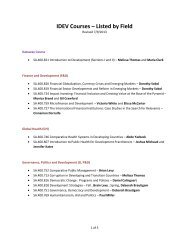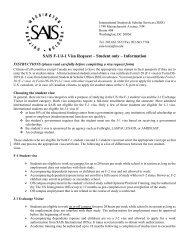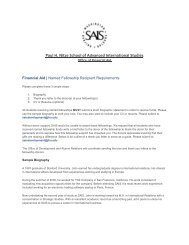Tunisia: Understanding Conflict 2012 - Johns Hopkins School of ...
Tunisia: Understanding Conflict 2012 - Johns Hopkins School of ...
Tunisia: Understanding Conflict 2012 - Johns Hopkins School of ...
You also want an ePaper? Increase the reach of your titles
YUMPU automatically turns print PDFs into web optimized ePapers that Google loves.
ather than shifts from low to high productivity sectors. Consequently, workers have not<br />
moved from low to high productivity sectors with higher earnings potential. New jobs did<br />
not require a more educated populace but simply more unskilled labor to fulfill the<br />
increase in productivity.<br />
<strong>Tunisia</strong>n Unskilled Labor Market<br />
The main employers <strong>of</strong> unskilled youth labor for non-qualified jobs or intermediate<br />
qualifications such as clerical support, service and sales, agriculture, plant and machine<br />
operation and assembling are in the following sectors: agriculture, public administration,<br />
construction, retail, manufacturing, transportation, telecommunications, hotels, and<br />
restaurants. In almost all these sectors, the net generation <strong>of</strong> youth employment exceeded<br />
the growth rate <strong>of</strong> youth labor participation due to the general growth in the private sector<br />
over the past decade. As a result, unemployment rates in these sectors have decreased.<br />
This clearly demonstrates that labor markets are not inefficient for unskilled workers.<br />
Thus, sustained economic growth <strong>of</strong> the private sector will help reduce youth<br />
unemployment, especially in the unskilled labor markets over the next 5-6 years.<br />
According to Marco Stampini and Audrey Verdier-Chouchane’s forecasting<br />
analysis, using the assumptions that: (a) the GDP elasticity <strong>of</strong> youth employment will<br />
remain constant at 0.24 (the average for the period 2005-07), and (b) GDP will grow by<br />
1.6% in 2011 (as a result <strong>of</strong> the revolution) and by a constant 4.5% from <strong>2012</strong>; youth<br />
unemployment is expected to have peaked at 26.2% in 2008, to have currently decreased<br />
to 25.4%, and to further decrease to 10.5% by 2018. Thus, creating more jobs for<br />
unskilled labor requires developing a business climate that fosters private investment,<br />
both foreign and domestic (See chapter by Rebekah Chang).<br />
Foreign investment from Europe and around the world will doubtless slowly<br />
increase as the country stabilizes; however, domestic investments such as building<br />
infrastructure are necessary in the short term to promote jobs and stabilize the economy<br />
in the long run. These investments will not only help jumpstart the economy by reducing<br />
the number <strong>of</strong> unemployed unskilled laborers, it will also help close the widening income<br />
and social gap between the richer coastal cities and the poor interior.<br />
189
















